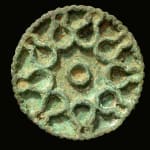Bactria-Margiana Openwork Copper-Alloy Stamp Seal, 2000 BCE - 1000 BCE
Copper-Alloy
3.5
LO.1041
Western Central Asia, now known as Turkmenistan, Uzbekistan, and northern Afghanistan, has yielded objects attesting to a highly developed civilization in the late third and early second millennium B.C. Although...
Western Central Asia, now known as Turkmenistan, Uzbekistan, and northern Afghanistan, has yielded objects attesting to a highly developed civilization in the late third and early second millennium B.C.
Although artifacts from the region indicate that there were contacts with Iran to the southwest, these seals were diffused uniquely within Central Asia and were never recovered in neighbouring countries such as Iran or Mesopotamia, suggesting that they must have been an indigenous production of the BMAC complex.
These distinctive openwork copper or bronze stamp seals, often called "compartmented" seals, were cast in lost wax in both geometric and figural patterns in Bactria-Margiana. On the front they were ornamented by various geometrical images and sometimes by a whole composition including people and animals. Such images were made by means of partitions on the front side of the seal, and that is why they are labelled compartmented. On the back they always had a loop-shaped handle, like the seal here illustrated, possibly held to make an impression in clay.
This copper-alloy example features a totally geometric composition with drop-like motifs radiating from a central roundel.The whole surface features a beautiful incrustation on both sides with iridescent speckles and splashes of azurite patina.
References: V. Sarianidi, Margus, 2002: pp. 258-279; and J. Aruz ed., Art of the First Cities, 2003: pp. 369-372.
Although artifacts from the region indicate that there were contacts with Iran to the southwest, these seals were diffused uniquely within Central Asia and were never recovered in neighbouring countries such as Iran or Mesopotamia, suggesting that they must have been an indigenous production of the BMAC complex.
These distinctive openwork copper or bronze stamp seals, often called "compartmented" seals, were cast in lost wax in both geometric and figural patterns in Bactria-Margiana. On the front they were ornamented by various geometrical images and sometimes by a whole composition including people and animals. Such images were made by means of partitions on the front side of the seal, and that is why they are labelled compartmented. On the back they always had a loop-shaped handle, like the seal here illustrated, possibly held to make an impression in clay.
This copper-alloy example features a totally geometric composition with drop-like motifs radiating from a central roundel.The whole surface features a beautiful incrustation on both sides with iridescent speckles and splashes of azurite patina.
References: V. Sarianidi, Margus, 2002: pp. 258-279; and J. Aruz ed., Art of the First Cities, 2003: pp. 369-372.



